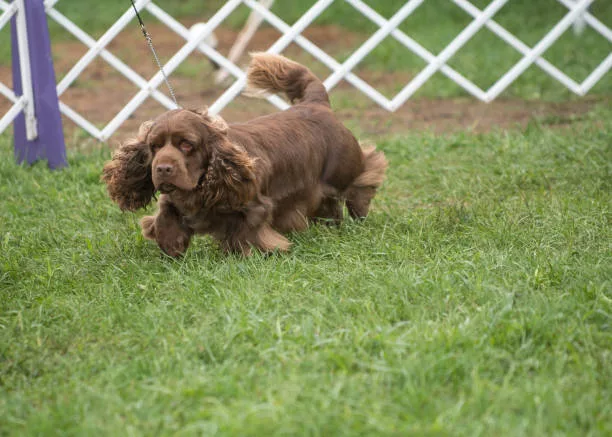The Sussex Spaniel is a rare and regal breed of dog, known for its gentle temperament, elegant appearance, and unwavering loyalty. It is one of the oldest spaniel breeds, dating back to the 18th century, and its history is intertwined with the English countryside. Though not as widely recognized as some of its spaniel cousins, the Sussex Spaniel possesses a unique charm that has captured the hearts of those fortunate enough to meet and share their lives with this exceptional breed.
A Rich History
The Sussex Spaniel’s origins can be traced back to the Wealden region of Sussex, England, where it was developed as a versatile hunting dog. Its compact size and keen sense of smell made it well-suited for flushing out game birds from dense brush and brambles. The breed’s distinctive golden liver coloration, thought to provide camouflage in the undergrowth, further enhanced its hunting capabilities.

Hunting Roots
In the 18th century, hunting was a popular pastime among the English gentry, and the Sussex Spaniel quickly gained recognition for its prowess in the field. Its small size allowed it to navigate through thick vegetation, while its strong nose could pick up the scent of game birds hidden in the underbrush. The breed’s ability to work independently and tirelessly made it a valuable asset to hunters.
Training and Care
To maintain their hunting skills, Sussex Spaniels require regular training and exercise. They have a high energy level and need daily walks or runs to keep them physically and mentally stimulated. Their intelligence and eagerness to please make them easy to train, but they do have a stubborn streak, so consistent and patient training is essential. As with any breed, early socialization and positive reinforcement are crucial for a well-behaved and well-adjusted dog.
Hunting Today
While the Sussex Spaniel’s hunting days may be behind them, many owners still enjoy participating in field trials and other sporting events with their dogs. These activities allow the breed to showcase its natural abilities and continue to honor its hunting heritage. Additionally, some owners have found success in training their Sussex Spaniels for other activities such as tracking, obedience, and agility.
From Hunter to Companion
Over time, the Sussex Spaniel’s role transitioned from a working dog to a beloved companion. Its gentle nature and affectionate personality made it a welcome addition to English households, where it became known as a gentleman’s spaniel. The breed’s popularity soared in the 19th century, with its presence gracing the estates of English nobility and literary works alike.
A Favorite of Royalty
The Sussex Spaniel quickly gained favor among the royal family, with Queen Victoria being one of its most notable admirers. She was known to have several Sussex Spaniels in her kennel and even had a favorite named “Dash.” The breed’s regal appearance and loyal nature made it a perfect companion for the queen, who often took her dogs on carriage rides and walks around the palace grounds.
Literary References
The Sussex Spaniel also made appearances in literature, further solidifying its place in English society. In Charles Dickens’ novel “David Copperfield,” the character Mr. Barkis has a beloved Sussex Spaniel named “Boxer.” The breed also appeared in the works of Sir Arthur Conan Doyle, including “The Adventure of the Sussex Vampire” and “The Adventure of the Retired Colourman.”
Beloved Family Pet
Today, the Sussex Spaniel continues to be a cherished family pet, known for its loving and gentle nature. Its calm demeanor and patience make it an excellent choice for families with children, and its size makes it suitable for apartment living. However, due to its history as a hunting dog, it may have a tendency to chase small animals, so proper socialization and training are essential.
Appearance and Characteristics
The Sussex Spaniel is a medium-sized breed with a sturdy and compact build. It has a distinctive golden liver coat that is dense and wavy, providing protection from the elements. The breed’s long, low-set ears and feathered tail add to its elegant appearance. Here are some key characteristics of the Sussex Spaniel:

- Height: 13-15 inches
- Weight: 35-45 pounds
- Life Expectancy: 12-14 years
- Coat Color: Golden liver
- Temperament: Gentle, affectionate, and loyal
- Activity Level: Moderate
- Grooming Needs: Regular brushing and occasional trimming
- Health Concerns: Hip dysplasia, ear infections, and obesity
Caring for Your Sussex Spaniel
As with any dog, proper care and attention are crucial for the health and well-being of your Sussex Spaniel. Here are some tips for keeping your furry friend happy and healthy:
Nutrition
A high-quality diet is essential for maintaining your Sussex Spaniel’s overall health. As an active breed, they require a balanced diet that provides them with the energy they need. Consult with your veterinarian to determine the best food for your dog based on their age, weight, and activity level. Avoid overfeeding, as the breed is prone to obesity, which can lead to other health issues.
Exercise
While not as high-energy as some other spaniel breeds, the Sussex Spaniel still requires daily exercise to keep them physically and mentally stimulated. A brisk walk or run, along with some playtime, should be sufficient to meet their needs. They also enjoy participating in activities such as retrieving and swimming, which can provide additional mental and physical stimulation.
Grooming
The Sussex Spaniel’s coat requires regular brushing to prevent matting and keep it looking healthy. Occasional trimming may be necessary, particularly around the ears and feet. They also have long, floppy ears that are prone to ear infections, so regular cleaning is essential. Additionally, their nails should be trimmed regularly to prevent overgrowth and discomfort.
Health Care
As with any breed, regular visits to the veterinarian are crucial for maintaining your Sussex Spaniel’s health. They are prone to hip dysplasia, a condition where the hip joint does not develop correctly, leading to pain and mobility issues. Regular check-ups can help detect this condition early on, allowing for proper treatment. They are also prone to ear infections, so keeping their ears clean and dry is essential.
Training Your Sussex Spaniel
The Sussex Spaniel is an intelligent breed that responds well to positive reinforcement training methods. Here are some tips for training your dog:

Start Early
Early socialization and training are crucial for any dog, but especially for breeds like the Sussex Spaniel, who may have a stubborn streak. Introduce them to different people, animals, and environments from a young age to help them become well-adjusted and confident adults.
Use Positive Reinforcement
Positive reinforcement training involves rewarding good behavior with treats, praise, or playtime. This method has proven to be more effective than punishment-based techniques, which can lead to fear and aggression in dogs. Be patient and consistent with your training, and your Sussex Spaniel will respond positively.
Keep Training Sessions Short
As with any breed, the Sussex Spaniel has a limited attention span, so keeping training sessions short (10-15 minutes) is essential. This will help keep them engaged and focused, making the training more effective.
Is a Sussex Spaniel Right for You?
The Sussex Spaniel is a loving and loyal breed that makes an excellent companion for individuals and families alike. However, before bringing one into your home, it’s essential to consider if the breed is the right fit for you. Here are some things to keep in mind:
Activity Level
While not as high-energy as some other spaniel breeds, the Sussex Spaniel still requires daily exercise and mental stimulation. If you lead a sedentary lifestyle or do not have the time to provide your dog with adequate exercise, this may not be the best breed for you.
Grooming Needs
The Sussex Spaniel’s coat requires regular brushing and occasional trimming, which can be time-consuming. If you are not willing to put in the effort to maintain their coat, this may not be the best breed for you.
Health Concerns
As with any breed, the Sussex Spaniel is prone to certain health issues, such as hip dysplasia and ear infections. While these conditions can be managed with proper care and attention, they may require additional time and financial resources.
Video
Conclusion
The Sussex Spaniel is a rare and regal breed that has captured the hearts of many with its gentle nature and elegant appearance. Its rich history and versatile abilities make it a unique and cherished member of the spaniel family. Whether as a hunting companion or a beloved family pet, the Sussex Spaniel continues to bring joy and companionship to those fortunate enough to share their lives with this exceptional breed.